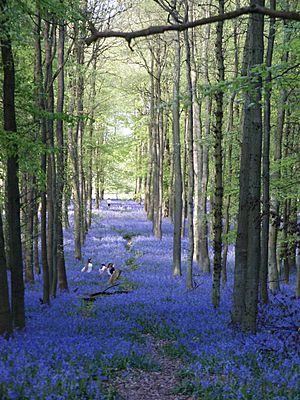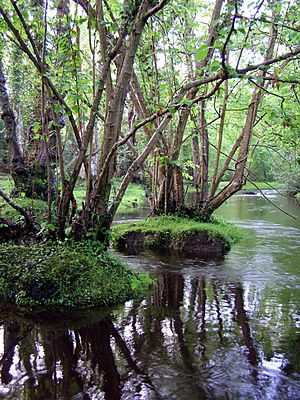English Lowlands beech forests facts for kids
Quick facts for kids English Lowlands beech forests |
|
|---|---|

Location of the English Lowlands beech forests
|
|
| Ecology | |
| Realm | Palearctic |
| Biome | temperate broadleaf and mixed forests |
| Borders | Celtic broadleaf forests |
| Geography | |
| Area | 45,600 km2 (17,600 sq mi) |
| Country | United Kingdom |
| Conservation | |
| Conservation status | critical/endangered |
The English Lowlands beech forests are a special type of ecoregion (a large area with similar plants, animals, and climate) found in the United Kingdom. They are located across much of Southern England, stretching from near Devon and South Wales in the west, up to the River Severn valley in the north-west, and into the East Midlands and Norfolk in the north-east. This area covers about 45,600 square kilometers (17,600 square miles). The World Wide Fund for Nature (WWF) and the European Environment Agency (EEA) have identified this ecoregion because of its unique features, especially its historic beech forests.
Contents
Where are these Forests?
This ecoregion is mostly in southern and eastern England. To the north, west, and south-west, you'll find a similar area called the Celtic broadleaf forests. This other ecoregion covers most of the rest of the British Isles.
The main difference between the English Lowlands beech forests and the Celtic broadleaf forests is the climate and land. South-eastern England is generally drier and warmer. The land is also lower. The ground here is often made of chalk (like the Southern England Chalk Formation). This area is mostly sedimentary rock, unlike the more metamorphic and igneous rocks found in the north-west of Great Britain.
What are these Forests Like?
In the past, much of this low-lying area was covered with tall forests. These forests were mostly made up of European beech trees. But other trees also grew there, like oak, ash, rowan, and yew.
During summer, these forests are usually cool and dark. This is because the beech trees grow a very thick canopy (the top layer of leaves). This dense canopy stops much sunlight from reaching the forest floor. Because of this, not many other trees or wild flowers can grow underneath.
However, in spring, before the beech trees grow all their leaves, you can find thick carpets of bluebells. These beautiful flowers bloom quickly, taking advantage of the sunlight before the forest floor becomes too shady.
The types of plants that grow in these beech forests depend on the soil.
- Some beech forests grow on base-rich soil (soil with lots of minerals).
- Others grow on mesotrophic soil (soil with a medium amount of nutrients).
- And some grow on acidic soil.
The River Thames is the most important river system in this area. Historically, its banks had forests of black alder trees, which you can still see sometimes today. This ecoregion also includes the unique ecosystems of the rivers themselves, along with their flood-meadows and estuaries. The soil is mostly based on limestone. The climate is temperate, meaning it's mild, with steady rainfall. Temperatures can drop below freezing in winter.
Today, much of this ecoregion has been turned into farmland. Farmers grow crops like wheat, barley, and rapeseed. They also raise animals like cattle and sheep. Many towns, suburbs, and villages are found almost everywhere, making it a very populated area. However, some wilder places still exist, like the Salisbury Plain.
London, one of the largest cities in the world, is located at the head of the Thames Estuary in this ecoregion. Because so many people live here, and due to problems caused by animals like the non-native grey squirrel, edible dormice (in the Chiltern Hills), and deer, these forests are considered to be at high risk. The WWF has given them a "critical/endangered" conservation status. Air pollution might also be causing a decrease in beech trees, making them more likely to get diseases.
Animals of the Forest
Many animals live in this ecoregion. Some common ones include:
Other animals are considered "near threatened," meaning they could be in danger in the future. These include:
- European otter
- Red squirrel
- Harvest mouse
- Hazel dormouse
- Greater horseshoe bat
- Corn crake
The barbastelle bat is even more endangered and is listed as a "vulnerable species."
Plants and Fungi of the Forest
Some rare plants found here are the red helleborine, bird's-nest orchid, and knothole yoke-moss. Rare fungi include the Devil's bolete and hedgehog mushroom.
History of the Forests
About 10,000 years ago, after the last Ice Age, this area was mostly a treeless tundra. Studies of pollen show that over time, birch trees grew, then pine trees. Around 4500 BC, most of the tree species we see today started to appear, including beech trees by 4000 BC. Beech trees are thought to have come from mainland Europe.
People used the triangular nuts (called "mast") from beech trees to make flour. They would soak the nuts to remove bitter substances called tannins. Beechmast was also traditionally fed to pigs.
However, around 4000 BC, the most common tree was not the beech, but the small-leaved lime (also known as the pry tree). The wild forests were a mix of lime-wood and hazel-wood areas, with some oak and elm trees. The small-leaved lime is less common now, possibly because the climate has changed, making it harder for its seeds to grow. Still, some old lime-wood areas remain in south Suffolk.
People started clearing forests when farming began, around 4500 BC. This happened especially in the higher parts of the country, like the South Downs. At that time, almost the entire region was heavily forested, except for farmed uplands and marshy areas.
Surviving Forests
Even though much forest has been cleared, some notable examples still exist today. These include:
- The Forest of Arden (Warwickshire)
- The Chilterns (running through Oxfordshire, Buckinghamshire, Hertfordshire, and Bedfordshire)
- Epping Forest (on the border of northeast Greater London and Essex)
- Kinver Edge (a small part of an old forest in Staffordshire and Worcestershire)
- Morfe Forest (south Shropshire)
- Savernake Forest (Wiltshire)
- Selwood Forest (Somerset)
- The Weald (in Kent, East Sussex, West Sussex, and Surrey)
- Wychwood (Oxfordshire)
- Wyre Forest (on the border of Worcestershire and Shropshire)
All these forests were once much larger. For example, a writer from the late 800s said that the Weald (which means "forest" in Old English) once stretched from Kent to Hampshire, and was about 120 miles (190 km) long and 30 miles (48 km) wide.
The New Forest (in southwest Hampshire) is the largest remaining forested area in this ecoregion, covering 571 square kilometers (220 square miles). Also, the system of hedgerows (lines of bushes and trees that separate fields) is very important. These hedgerows act as habitats for woodland animals that have lost their original forest homes. Some hedgerows are very old, dating back 700 to 1,000 years.
Important places for birds include the estuaries of the Thames and Severn rivers, and the mid-Essex coast.
The Jurassic Coast World Heritage Site shows the area's ancient past. Here, you can see about 180 million years of fossil-rich rock layers along 95 miles (153 km) of the Dorset and East Devon coast. The science of palaeontology (the study of fossils) largely began here, thanks to the pioneering work of Mary Anning.
In 1987, a very strong storm called the Great Storm of 1987 hit this area. It caused about 15 million trees to be uprooted (blown over).
See also
 In Spanish: Hayedo de las tierras bajas de Inglaterra para niños
In Spanish: Hayedo de las tierras bajas de Inglaterra para niños



